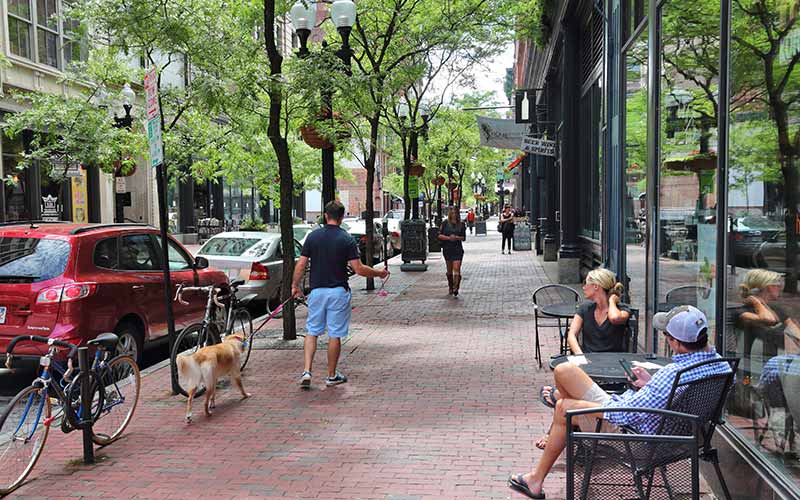
From filtering air pollution to cooling homes, urban trees play a vital role in safeguarding our health and environment. Photo: Shutterstock
Everyone loves the look of a street lined with a lush, leafy tree canopy, but did you know that city trees can also have powerful positive impacts on your environment and well-being? Trees play an underappreciated role in our metropolitan ecosystem, and the benefits could be even greater if we better nurture our urban forests. Here are six ways that a robust tree canopy can benefit your neighborhood!
1. Urban trees decrease flooding and polluted runoff
In a thunderous rainstorm, trees can make the difference between dangerous flooding and walkable streets. If you’re tired of picking your way around puddles on your way to work, well-placed trees could be the solution. A single medium-sized tree can soak up as much as 2380 gallons of rain every year!
In addition to reducing flooding, trees can decrease the amount of contaminated runoff fouling our waterways. Rainwater flowing through an urban environment can pick up toxic pollutants before being swept down drains and into rivers, lakes, and streams. Trees interrupt that process, absorbing much of the runoff before it can reach vulnerable waterways and the flora and fauna that rely on them.
2. Urban trees filter air pollution
In addition to absorbing water pollutants through their roots, trees filter significant air pollution through their leaves. Every breath we take is a little cleaner thanks to the trees around us!
Living in an environment with plenty of trees makes you less likely to develop a respiratory illness like asthma. If you already have an illness that’s aggravated by air pollution, trees can make your symptoms less severe. The impact is so powerful that trees actually reduce healthcare costs in the surrounding community.
3. Urban trees make our streets (and homes) cooler
The shade cast by trees can drop temperatures dramatically on hot, sunny days. As climate change causes average temperatures to rise, this will only grow more valuable.
Lower temperatures can improve people’s health as well as their comfort. Neighborhoods with robust tree canopies have lower risks of serious heat-related illnesses. Without the shade cast by trees, pavement can quickly get too hot for humans and animals to touch. Trees protect our bare skin and our pets’ delicate paws from pain or burns.
The benefits aren’t limited to the outdoors. Buildings shaded by trees have significantly lower temperatures inside, reducing the need for air conditioning. In turn, this cuts utility bills and takes the strain off the electrical grid.
4. Urban trees absorb carbon pollution
This is the environmental benefit that trees are famous for. They absorb huge amounts of carbon dioxide and release oxygen, which is crucial in fighting climate change. Undeveloped areas get most of the credit for their climate benefits. Still, urban forests soak up 45 million tons of carbon annually in the U.S. – enough to offset nearly 10 million cars. With more strategic planting, urban green spaces could absorb another 70 million tons!
Reforesting wild areas will be essential to stopping climate change, but planting in urban areas is another vital piece of the puzzle.
5. Urban trees reduce noise pollution
Trees can muffle the sounds of traffic and other disruptive noises. This peace and quiet can significantly benefit your health. Too much noise in your environment can lead to higher rates of stress-related illnesses, high blood pressure, hearing loss, and sleep problems. Trees, especially when planted in clusters, can provide some much-needed tranquility.
6. Urban trees improve your mental health
You may have noticed that a pleasant walk through an urban greenspace can improve your mood. You aren’t alone – studies have found that exposure to trees can improve people’s mental health in measurable ways. People with easy access to trees experience less depression, stronger senses of community, and lower rates of anxiety. Just looking at green landscapes can boost children’s ability to focus and bounce back from stress, which can even improve test scores.
The upsides of urban trees are impressive, but they’re not distributed evenly. Historically, wealthier and whiter communities have enjoyed the benefits of leafy canopies, while lower-income communities and communities of color have lived with noisier, hotter, and more flood-prone streets. In fact, neighborhoods of color have 33% fewer trees than predominantly white communities, while low-income neighborhoods have 41% fewer trees than wealthier communities.
You can see where your town – and the towns around you – stacks up by checking your “Tree Equity Score.” Urban forestry can benefit everyone’s community, but only if we actively and equitably cultivate it.



